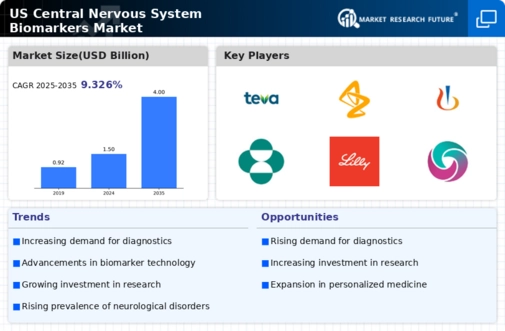Growing Demand for Early Diagnosis
The increasing emphasis on early diagnosis of neurological conditions is significantly impacting the central nervous-system-biomarkers market. Early detection is crucial for effective intervention and management of diseases such as Alzheimer's and Parkinson's, where timely treatment can slow disease progression. The market is witnessing a shift towards the development of biomarkers that can facilitate early diagnosis, with studies indicating that early intervention can improve patient outcomes by up to 40%. This growing demand for early diagnostic solutions is likely to drive innovation and investment in the central nervous-system-biomarkers market, as healthcare providers seek to implement strategies that enhance patient care.
Advancements in Diagnostic Technologies
Technological innovations in diagnostic methodologies are significantly influencing the central nervous-system-biomarkers market. The integration of advanced imaging techniques, such as MRI and PET scans, alongside biomarker analysis, is enhancing the accuracy of neurological disorder diagnoses. For instance, the use of neuroimaging combined with biomarker profiling has shown to improve diagnostic precision by up to 30%. As these technologies evolve, they are likely to facilitate the identification of biomarkers that can predict disease progression and treatment response. Consequently, the central nervous-system-biomarkers market is poised for growth as healthcare systems increasingly adopt these sophisticated diagnostic tools to improve patient care and streamline clinical workflows.
Increased Funding for Neuroscience Research
The surge in funding for neuroscience research is a crucial driver for the central nervous-system-biomarkers market. Government and private sector investments have been on the rise, with the National Institutes of Health (NIH) allocating over $3 billion annually for brain research initiatives. This financial support fosters innovation in biomarker discovery and validation, enabling researchers to explore new avenues for understanding complex neurological conditions. As funding continues to grow, the central nervous-system-biomarkers market is likely to expand, driven by the development of novel biomarkers that can lead to breakthroughs in treatment and management of neurological disorders.
Rising Prevalence of Neurological Disorders
The increasing incidence of neurological disorders in the US is a primary driver for the central nervous-system-biomarkers market. Conditions such as Alzheimer's disease, Parkinson's disease, and multiple sclerosis are becoming more prevalent, with estimates suggesting that by 2030, approximately 7.2 million individuals will be living with Alzheimer's alone. This surge in cases necessitates the development of effective diagnostic tools, thereby propelling the demand for biomarkers that can aid in early detection and monitoring of these diseases. The central nervous system biomarkers market is expected to witness substantial growth as healthcare providers seek innovative solutions to address the challenges posed by these disorders. This growth will ultimately enhance patient outcomes and reduce healthcare costs.
Regulatory Support for Biomarker Development
Regulatory bodies in the US are increasingly supporting the development of biomarkers through streamlined approval processes and guidelines. The FDA has established programs aimed at expediting the review of biomarker-based diagnostics, which encourages innovation in the central nervous-system-biomarkers market. This regulatory support not only facilitates faster market entry for new biomarkers but also enhances collaboration between industry stakeholders and regulatory agencies. As a result, the central nervous-system-biomarkers market is expected to benefit from a more favorable environment for research and development, ultimately leading to the introduction of novel diagnostic tools that can improve patient management.
























Leave a Comment